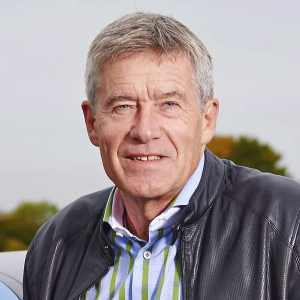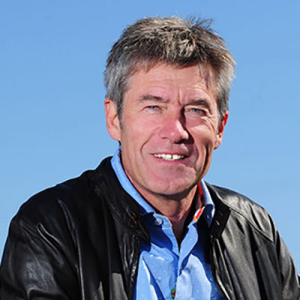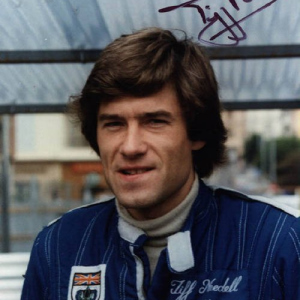Tiff Needell
| Tiff Needell | |
|---|---|
|
| |
| Full Name | Timothy Needell |
| Nationality |
|
| Birthday | 29th October |
| Sex | Male |
| Occupation |
Presenter of Top Gear (1977 TV series) Presenter of Fifth Gear Presenter of Lovecars |
| On-screen debut | Top Gear: Series 17, Episode 1 (1987) |
| Final appearance | Lovecars OTR: Episode 6 (2020) |
Timothy "Tiff" Needell was a British racing driver and later automotive journalist who helped to present the original incarnation of BBC's Top Gear from its 17th series in 1987 through to its cancellation at the end of its 45th series in 2001, before famously defecting to Channel 5 in order to present Fifth Gear. Following a seventeen year stint with the programme, Needell would be surprisingly axed[1] by Discovery executives for undisclosed reasons, leading him to close his career under a new company, Lovecars, which produced the shortlived TV series Lovecars: On The Road.
Early life
Born in 1951 in Havant, Hampshire, Needell was the younger son of Diana and Anthony Fairey "Tony"[2] Needell, a pre-war spectator and auto-tester at the famed Brooklands circuit who later became a significant figure[3] in the world of powerboat racing and naval[4] architecture. Growing up, Needell attended Ottershaw[5] School before attaining an Honours Degree in Civil Engineering[6] at City University, graduating in 1974. As a child, Needell was "dragged"[7] to Goodwood by his father, where he witnessed star drivers of the era such as Mike Hawthorn and Stirling Moss. From there, the young Needell was hooked, and bought a Yamato Pax[8] M4[9] in order to capture his heroes on film. He would compile together various scrapbooks of photographs captured at motor racing events, developing the films himself whilst at boarding school. Many of these photographs were later republished in the May 2011 issue of Motorsport Magazine.
"Tiff"
As he grew up with his older brother Michael (1948 - c.1985/6)[10][11], Needell found himself unable to correctly pronounce his name, saying "Tiff" instead of "Timothy". From there, his nickname stuck throughout his entire life.
Career until 2002
Through his own[12] admission, Needell considers his career as having started in 1977, the year he became a professional racing driver after having first sat in a racing car six years earlier[13] as a result of winning a competition organised by Autocar. Despite success in many junior formulae throughout the 1970s to the extent that in 1976 he was considered the country's most promising young driver, in 1979 Needell would be denied his FISA application in order to race in Formula 1 that year for the Ensign team, losing out his drive to Frenchman Patrick Gaillard. He would re-apply the following year, and successfully get the drive after Clay Regazzoni suffered[14] a career-ending injury at the 1980 United States Grand Prix West. Of two attempts, Needell would qualify just once, at the 1980 Belgian Grand Prix[15] at Zolder, where he started 23rd, initially ahead of before trailing behind Brazilian F1 and Indycar legend Emerson Fittipaldi, until Needell's Cosworth engine gave out during the thirteenth lap after having climbed to 19th place largely through attrition. Needell would never start another F1 race, being booted from the team in favour of Dutchman Jan Lammers after failing to qualify at Monaco, effectively ending his open-wheel career.
During the first half of the 1980s, Needell would join the BBC and begin providing commentary for certain racing events and programmes, including Grandstand[16] in a role he would hold until at least 1985, alongside renowned sports commentators Murray Walker and Des Lynam. He would continue to have mild success in motor racing on a part-time basis, winning the 1989 Donington 1 Hour[17] endurance race with team-mate Laurence Bristow, as well as placing 3rd[18] during the 1990 running of the 24 Hours of Le Mans. However, anything beyond glimpses of success were relatively few and far between following his unlucky foray into open-wheeled racing, and he began to develop more of an interest in a broadcasting career.
Early Top Gear career
Following administrative changes made to the programme in 1986, Tiff Needell would be scouted[19] by new Top Gear producer Ken Pollock, who felt he would be an excellent addition to the team due to being a more than competent driver who could talk about his experiences whilst driving. He would be given a role on Top Gear around the same time as future fellow colleague Jeremy Clarkson, but would beat the latter in terms of a television debut by appearing in the programme's seventeenth series premiere under the tenure of William Woollard, during which he was given the role of test driving a Van Diemen Formula First racing car at Brands Hatch as part of a film otherwise presented by Chris Goffey. From there, Needell would make frequent appearances for racing films or other segments which required advanced driving techniques, such as demonstrating overtaking in a Ford Escort XR3, as well as driving the famed 1903 Napier Gordon Bennett around a private course. He would gradually move towards general road testing as the late 1980s progressed, representing the 1970s for Top Gear's Car of the Decade special which kicked off the programme's twentieth series, behind the wheel of the finalist for that respective decade; the Alfa Romeo Alfasud. He would also test drive the Volkswagen Corrado in the episode which aired one week prior to Jeremy Clarkson's debut in 1988.
Rise to prominence
With both Frank Page and Sue Baker having left Top Gear in 1988, Tiff Needell began to appear more and more frequently, becoming the third-most frequently appearing host during 1989's Series 21 and 1990's Series 23. Throughout the intermediate Series 22, several of Needell's racing exploits were filmed and broadcast on Top Gear, including his win at Donington in the Ford Sierra RS500 and his partnership with sports car legend Derek Bell in the Porsche 962. That same series would also see Needell participate in the yearly Brighton Speed Trials, where he drove[20] a Lotus Esprit. In November 1990, Top Gear would become the first television series produced in the West to test drive the Honda NSX, with Needell behind the wheel. As he became a more familiar face to audiences, he began driving less-sporty cars, such as the Yugo Sana and became more of a well-rounded automotive journalist as opposed to just focusing on motorsport. In 1991, during what was William Woollard's last ever episode of Top Gear as lead host, Needell would drive the Jaguar XJR-15 at full throttle around Silverstone. A year later, he would test drive another high-powered Jaguar, the XJ220, and during the Le Mans weekend would task Formula 1 driver Martin Brundle with taking the car to its top speed at the Nardò ring in Italy. After removing the catalytic converters, it was found the car was capable of 217 MPH, or the equivalent of 223 MPH on a straight road.
He would develop an on-screen rapport with subsequent lead host Jeremy Clarkson, and by 1994, the pair were relatively synonymous with one another, appearing on Top Gear's first ever home video release, Super Cars, which compiled together several of their drives in one video, including the aforementioned XJ220 and NSX drives, as well as Tiff's review of the Porsche 964 Turbo.
Return to full-time competition
For two seasons, Tiff Needell would return to the BTCC in an ultimately unsuccessful bid with Nissan following a one-off drive for the Écurie Ecosse team. At Donington Park, the same circuit which he had won in the Ford Sierra 4 years earlier, Needell would run in 5th immediately behind the BMW of Steve Soper and the Ford Mondeo of Nigel Mansell during the TOCA Shootout. At the Bridge section of the track, Mansell would briefly lose control of his car, ceding 4th position to Soper who passed uneventfully, but would be clipped by Needell, sending Mansell into the wall[21] and knocking both drivers unconscious. Needell would escape relatively unscathed, but Mansell would be sent[22] to the hospital, sustaining head and spinal injuries and causing the crowd to boo Needell, who felt the latter was at fault. The incident brewed significant animosity between Mansell and Needell, who maintained a feud for years after the accident.
Beginning from 1996, Needell would partner up with Lister, who produced the Storm sports car in order to race a GT version at Le Mans and British GT. During the 2000 season of the latter, Needell would win all three races he entered, though unfortunately only one of these victories would officially count for championship points, as the team he entered with had not registered their entry by the competition's initial deadline.
Tenure as lead host
After solely hosting the Land Speed Record Special at the end of Top Gear's fortieth series in late 1998, Tiff Needell would be unexpectedly thrust into the role of lead host after Jeremy Clarkson publicly announced[23] his departure from the programme early the following year. He would be partnered by James May, but by the end of the subsequent 41st series, May was dismissed and Needell took on full duties as lead host.
On the 7th February, 1999, Needell would drive a McLaren F1 to speeds of over 200 MPH[24] around Millbrook Proving Ground in Bedfordshire, the fastest lap ever set at the course. That July, Needell would visit[25] the Shell Eco-Marathon and marvel at its competitors, almost capable of breaching 10,000 miles per gallon.
Departure from Top Gear
In August 2001, the BBC announced[26] that Top Gear in its previous incarnation was to be discontinued after 23 years on the air. This meant an uncertain future for three of its main hosts, including Needell, who after meeting with former colleague Richard Pearson in the Autumn of that year, decided to move[27] to rival broadcaster Channel 5. The resultant programme, rechristened as Fifth Gear, would premiere[28] in April of 2002 and recycle much of the format that the outgoing Top Gear had employed. Public reception[29] to this new series was largely positive, and put pressure on the BBC to deliver a suitable replacement, which it would do later that year.
Career since 2002
Upon his move to Fifth Gear, reuniting with host Quentin Willson in the process, who had not been seen on television since Series 43 of the earlier programme back in 2000, Needell immediately got to work. He drove several supercars during Fifth Gear's inaugural series, such as the Lamborghini Murciélago and Pagani Zonda, as well as breaking the first of several records Fifth Gear would either break or set; the fastest ever recorded 0-60 time, which Needell would achieve[30] in a Tiger Z100 kit car, setting a time of 2.9 seconds against the then-previously standing record held by a Ford RS200. At the end of the series, Tiff, along with Vicki, would participate in a 2 hour long endurance race in a Radical sports car.
That October, Needell would release 20 Cars That Changed The World, a home video compiled entirely of digitised footage from older series of Top Gear. This included footage such as Needell in the Napier Gordon Bennett, and Helen Mound in the Messerschmitt KR200.
Selected filmography
Unabridged article: Filmography
- Grand Prix: 1980 (1 episode - Belgian Grand Prix)
- Top Gear: 1987 - 2001 (236 episodes)
- Fifth Gear: 2002 - 2018 (173 episodes)
- Lovecars: On The Road: 2020 (6 episodes)
Trivia
- Despite his deceptively youthful appearance, Needell was already 50 years old upon Top Gear's initial cancellation in 2001.
- From 1987 until 2015, Needell maintained a record of longest continuous television career for a British automotive personality, overtaking Chris Goffey in 2011, by appearing in at least one automotive journalism themed programme per year.
References
- ↑ Motor1 - Tiff Needell axed from Fifth Gear.
- ↑ Motorsport Magazine - Tiff's early focus.
- ↑ Sail-World - Powerboat records on Lake Windermere - A Brief History.
- ↑ Harmsworth Trophy - The Trustees.
- ↑ Ottershaw School Old Boys' Society - Notable Old Boys.
- ↑ City, University of London - Tiff Needell.
- ↑ (Archive link) Auto Trader UK - "I could have been Lewis Hamilton".
- ↑ Locally distributed as a "Pal M4".
- ↑ Camera-wiki.org - Pax M4.
- ↑ Geni - Michael Needell (1).
- ↑ Geni - Michael Needell (2).
- ↑ LinkedIn - Tiff Needell.
- ↑ Grandprix.com - Drivers: Tiff Needell.
- ↑ Historic Racing - Clay Regazzoni biography.
- ↑ StatsF1 - Belgium 1980.
- ↑ BBC Genome - Sunday Grandstand. (20th March, 1983)
- ↑ Touring Car Racing - 1989 BTCC - round 4.
- ↑ Racing Sports Cars - Le Mans 24 Hours 1990.
- ↑ Roach, M. (2011) The Top Gear Story. London: John Blake Publishing Ltd., pp. 12-13.
- ↑ Brighton Speed Trials - 1989 Programme. (PDF)
- ↑ The Fastlane - TOCA Shootout 1993.
- ↑ Allsop, D. (1993) 'Motor Racing: Mansell in hospital after crash: British hero's return home ends with high-speed accident in touring car 'shoot-out'.', The Independent, 1st November.
- ↑ BBC News - Clarkson slips out of Top Gear.
- ↑ Meaden, R. (2019) 'Think race circuits are scary? You should try a test track or proving ground.', evo, 4th June.
- ↑ BBC News - Car achieves almost 10,000 miles per gallon.
- ↑ BBC News - BBC takes Top Gear off road.
- ↑ BBC News - Top Gear team switch lanes.
- ↑ BBC News - Top Gear finds a new home.
- ↑ BBC News - 5th Gear: Your views.
- ↑ Tiger Racing - Tiger Z100.
| |||||||||||
- British automotive journalists
- Automotive journalism figures born on 29th October
- Presenters of Fifth Gear
- Male presenters of Fifth Gear
- Presenters of Lovecars
- Male presenters of Lovecars
- Tiff Needell
- Profile pages
- Male automotive journalists
- Presenters of Top Gear (1977 TV series)
- Male presenters of Top Gear (1977 TV series)
- Automotive journalists who made their on-screen debuts in 1987
- Automotive journalists who made their final on-screen appearances in 2020


